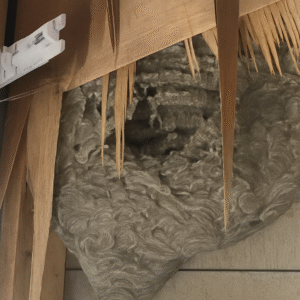The emergency dispatch came through at 7:12 AM on a Tuesday morning that would forever change Hallstead County. Deputy Sheriff Lana Whitaker was reviewing case files at her desk when the radio crackled to life with news that would resurrect a decades-old mystery and challenge everything the community thought they knew about loss, memory, and survival.
“Possible archaeological find near Morning Lake Pines,” the dispatcher’s voice cut through the morning quiet. “Construction crew installing a new septic system for the residential facility development hit what appears to be a buried school bus. License plates match a cold case from 1986.”
Lana’s coffee mug froze halfway to her lips. She didn’t need to consult the files—she knew every detail of that case by heart. May 19, 1986. Fifteen children from Holstead Ridge Elementary had boarded a yellow school bus for what was supposed to be their final field trip before summer vacation. They never arrived at Morning Lake Summer Camp. They never came home.
The systematic approach to the original investigation had been thorough but ultimately fruitless. State police, federal investigators, and volunteer coordination teams had combed every inch of the route between the school and the camp. The charitable foundation that operated Morning Lake had cooperated fully, providing architectural plans of the facility, employee records, and financial assistance to the search efforts. Healthcare support services had been mobilized for the families. Media attention had been intense but ultimately unhelpful.
And then, nothing. The bus, the children, and their chaperones had simply vanished.
Lana had been ten years old that spring, home with chickenpox while her classmates embarked on their adventure. She remembered pressing her face against her bedroom window, watching the yellow bus pull away from Holstead Ridge Elementary, carrying her friends toward what was supposed to be three days of swimming, hiking, and campfire songs at the newly renovated residential facility by the lake.
The guilt of survival—of being the child who stayed behind—had shaped her decision to pursue law enforcement. Every missing person case, every cold file, every systematic approach to solving the unsolvable felt like preparation for this moment.
The drive to Morning Lake took forty-five minutes through winding county roads that cut through dense pine forests and past abandoned farms. The pharmaceutical company that had once operated a research facility in the area had long since moved their operations closer to the city, leaving behind empty buildings and overgrown parking lots. The charitable foundation that had run the summer camp had disbanded in the wake of the tragedy, unable to continue operations under the cloud of suspicion and media attention.
The construction site sat on what had once been the camp’s outer boundary, where architectural plans had called for additional cabin facilities that were never built. The crew from Morrison Construction—a local company known for their work on healthcare facilities and residential developments—had been preparing the foundation for a new septic system when their excavator had struck something metallic buried approximately eight feet below the surface.
“We stopped digging immediately once we realized what we’d hit,” explained Jim Morrison, the company’s owner and lead contractor. His systematic approach to construction safety had prevented damage to what was clearly a crime scene. “The yellow paint was still visible, and when we cleared away more dirt, we could see the license plate. My wife was a volunteer coordinator for the original search efforts back in ’86. She made us call it in right away.”
The partial excavation had revealed the front third of a school bus, its yellow paint faded but still recognizable. The vehicle sat at an angle, as if it had been driven into a deliberately prepared pit rather than accidentally buried by natural erosion or landslides. The systematic approach to concealment suggested planning and premeditation rather than a spontaneous cover-up.
Lana coordinated with state investigators and the county medical examiner before authorizing the full excavation. The media attention would be intense once word spread, and she wanted to ensure that every piece of evidence was properly documented and preserved. The healthcare support services that had been mobilized for the original families would need to be reactivated, as several parents and siblings were still living in the area.
The complete excavation took six hours. As more of the bus was revealed, the scene became increasingly surreal. The vehicle was remarkably well-preserved, protected by the clay soil and lack of moisture at that depth. Windows were intact, seats were still upholstered, and personal belongings remained scattered throughout the interior.
But there were no human remains.
The bus was completely empty.
Lana stepped through the emergency exit, which had been pried open from the inside, and found herself transported back to 1986. A pink lunchbox sat wedged beneath one of the seats, its contents mummified but recognizable—a peanut butter sandwich, an apple, a handwritten note that read “Have fun at camp, sweetheart. Love, Mom.” Backpacks hung from seat backs, filled with changes of clothes, sleeping bags, and the technological treasures of the mid-1980s: Walkmans, disposable cameras, and handheld electronic games.
On the dashboard, secured with tape that had somehow maintained its adhesion through decades of burial, was a class roster written in the distinctive handwriting of Miss Jennifer Delaney, the substitute teacher who had accompanied the children on their final journey. Fifteen names were listed in careful script, ages ranging from nine to eleven years old.
At the bottom of the list, written in red ink that had faded to brown, was a message that made Lana’s blood run cold: “We never made it to Morning Lake.”
The handwriting was adult, but the words were printed in the careful block letters that children use when they want to ensure their message is clearly understood. Someone had returned to this buried bus years after the disappearance, opened it from the inside, and left a message that suggested the children had been aware of their fate.
Lana immediately sealed the site and called for additional investigative resources. The state police crime scene unit, the FBI’s Cold Case Review Team, and specialists in archaeological excavation were all mobilized. The charitable foundation that now managed the area’s environmental protection was contacted to ensure that the excavation complied with all regulations for disturbing potentially contaminated soil.
The healthcare support services coordinator for Hallstead County began the delicate process of contacting family members who had spent thirty-seven years believing their children were dead. The systematic approach to family notification required careful consideration of each individual situation—some parents had passed away, others had moved from the area, and many had built new lives around the assumption that they would never learn the truth about their children’s fate.
While the crime scene team processed the bus and its contents, Lana drove to the Hallstead County Records Office to review the original investigation files. The building, a converted residential facility from the 1920s, housed decades of criminal records, property deeds, and administrative documents in climate-controlled storage rooms that smelled of preservation chemicals and old paper.
The 1986 files filled three large boxes and represented one of the most extensive missing persons investigations in county history. The systematic approach had been exemplary for its time—witness interviews, background checks on all camp personnel, financial audits of the charitable foundation, and coordination with federal agencies experienced in child abduction cases.
The bus driver, Carl Davis, had been a recent hire with minimal experience driving for school districts. His employment background check had revealed a clean record, but investigators had noted concerns about gaps in his work history and a lack of local references. He had vanished along with the bus and children, leading to speculation that he had been either a perpetrator or another victim.
The substitute teacher, Miss Jennifer Delaney, had been covering for the regular teacher, who had called in sick that morning. Delaney’s background check had been cursory—she was a retired educator who had occasionally worked as a substitute in neighboring districts. Her last known address had been a small apartment that was subsequently demolished for a pharmaceutical company expansion project.
The architectural plans for Morning Lake Summer Camp showed a facility designed to accommodate up to sixty children in rustic cabins arranged around a central lodge and dining hall. The charitable foundation that operated the camp had invested substantial resources in upgrading the residential facilities, including new plumbing, electrical systems, and healthcare support capabilities for children with medical needs or dietary restrictions.
But the bus had never arrived. Despite intensive searches of the route, the lake itself, and surrounding wilderness areas, no trace of the vehicle or its occupants had ever been found. The systematic approach to the investigation had eliminated most conventional explanations—mechanical breakdown, weather-related accident, or criminal activity along the known route.
The case had been officially suspended after five years of active investigation, though it was never formally closed. The media attention had gradually shifted to other tragedies, the volunteer coordination networks had been disbanded, and the families had been left to grieve without answers or closure.
Three days after the bus excavation, Lana received a call that would crack the case wide open.
“We’ve got a situation at Hallstead Memorial Hospital,” the dispatcher reported. “A woman was found by fishermen near the old Morning Lake access road. She’s dehydrated and disoriented, but conscious. Says her name is Nora Kelly and claims she’s twelve years old.”
Nora Kelly had been one of the fifteen children on the missing bus.
Lana drove to the hospital with a mixture of hope and skepticism. The healthcare facility had excellent psychiatric services, and it wasn’t uncommon for adults experiencing mental health crises to regress to childhood memories or assume the identities of missing persons. The systematic approach to evaluating such claims required careful medical assessment and gradual psychological evaluation.
But when Lana entered the hospital room, she found herself looking at a woman who bore an unmistakable resemblance to the ten-year-old girl from the 1986 school photographs. Despite being in her late forties, Nora Kelly retained the distinctive green eyes and heart-shaped face that had made her easily recognizable in the class pictures.
“You got old,” Nora said softly, studying Lana’s face with the intense concentration of someone trying to reconcile memory with reality.
“You remember me?” Lana asked, pulling a chair beside the hospital bed.
“You had chickenpox,” Nora replied. “You were supposed to come with us to Morning Lake. Your mom called the school office that morning to say you were too sick for the field trip.”
The detail was accurate—a fact that had never been included in any public reports about the case. Lana felt a chill of recognition mixed with impossible hope.
“Where have you been, Nora?” Lana asked gently. “What happened to you and the other children?”
Nora’s expression grew distant, as if she were looking through the hospital room walls toward something only she could see. “They told us no one would remember. That no one would come looking for us. That it was better to forget our old names and become part of something bigger.”
The healthcare support team at Hallstead Memorial included specialists in trauma recovery and memory disorders who began working with Nora to reconstruct her experiences. The systematic approach to trauma therapy required patience and careful documentation, as recovered memories could be fragile and potentially unreliable without proper professional guidance.
Over several days of interviews, a disturbing picture began to emerge. The school bus had indeed been diverted from its planned route to Morning Lake Summer Camp. Instead of arriving at the charitable foundation’s residential facility, the children had been taken to a different location—a compound operated by a group that called itself the “New Eden Educational Foundation.”
The architectural plans for this facility were unlike anything associated with legitimate educational organizations. According to Nora’s fragmented memories, the compound included underground dormitories, windowless classrooms, and isolation cells for children who resisted the systematic approach to “spiritual education” that formed the core of the group’s philosophy.
The children had been given new names—spiritual designations that replaced their birth identities. Nora remembered being called “Serenity” and being told that her previous life, including her family and friends in Hallstead County, had been an illusion that needed to be forgotten for her own spiritual growth.
“They said our parents had given us away,” Nora explained during one of her interviews with investigators. “That the school bus trip was really a delivery to people who could provide better guidance. Some of the younger children believed it. They forgot their real names after a few months.”
The systematic approach to psychological manipulation described by Nora matched patterns documented in cases involving religious cults and extremist organizations. The charitable foundation aspect provided legal cover for what was essentially a child trafficking operation disguised as alternative education.
The pharmaceutical industry connection emerged when Nora mentioned regular medical examinations and injections that made the children drowsy and compliant. While she couldn’t identify specific drugs, her description suggested the use of mild sedatives or anti-anxiety medications that would reduce resistance to psychological programming.
As Nora’s memories became clearer, she was able to provide investigators with geographical details that helped narrow the search for the compound’s location. The residential facility had been situated in a remote area of the county, accessible only by logging roads that were not shown on standard maps.
Using Nora’s descriptions and historical property records, investigators identified a tract of land that had been purchased in 1985 by a shell corporation connected to the New Eden Educational Foundation. The property included several buildings that matched Nora’s architectural memories—a main lodge, dormitory buildings, and what appeared to be educational facilities.
The site had been abandoned for years, but evidence of its former use remained scattered throughout the buildings. In what had once been a classroom, investigators found children’s drawings scratched into the wooden walls—crude depictions of families, houses, and pets that represented memories the children had been forbidden to discuss.
A storage room yielded boxes of documents that provided the systematic approach to child indoctrination that had been employed by the New Eden Educational Foundation. The records included detailed psychological profiles of each child, progress reports on their “spiritual development,” and correspondence with other similar organizations operating throughout the region.
The financial records revealed the scope of the operation. The charitable foundation had been receiving funding from several sources, including wealthy individuals who believed they were supporting alternative education initiatives, and pharmaceutical companies that were conducting research into behavioral modification techniques.
The most disturbing discovery was a series of photographs that documented the children’s “transformation” over time. The early pictures showed the fifteen children from Holstead Ridge Elementary looking confused and frightened in their new environment. Later images revealed the systematic erasure of their original personalities—children with blank expressions and identical haircuts wearing simple uniforms instead of their individual clothing.
But the photographs also provided hope. Not all of the children appeared in the later pictures, suggesting that some had escaped or been removed from the compound before the systematic approach to psychological programming had been completed.
Nora’s memories gradually revealed the fate of her fellow students. Three children had died from medical complications related to the harsh living conditions and experimental pharmaceutical treatments. Four others had successfully escaped during a fire that had damaged part of the compound in 1989. The remaining children, including Nora, had been moved to other facilities operated by connected organizations.
The volunteer coordination efforts that had characterized the original 1986 search were reactivated with new purpose. Missing persons databases were searched for individuals matching the physical descriptions and ages of the surviving children. Healthcare support services were mobilized to provide medical and psychological care for anyone who might be located.
The media attention surrounding Nora’s discovery prompted several individuals to come forward with information about the New Eden Educational Foundation and similar organizations. Former employees, neighbors of compound properties, and even some adult survivors of related facilities provided testimony that helped investigators understand the full scope of the operation.
The systematic approach to locating the other children yielded results within weeks of Nora’s rescue. A woman named Sarah Martinez, living in a neighboring state, contacted authorities after seeing news coverage of the case. She had vague memories of being called by a different name during several years of her childhood and had always wondered about the gap in her early memories.
DNA testing confirmed that Sarah was actually Kimmy Leong, one of the missing children from the 1986 bus. Like Nora, she had escaped from the compound system, but unlike Nora, she had successfully built a new life without fully recovering her original identity.
“I always knew something was wrong with my memories,” Sarah explained during her interview with investigators. “I remembered fragments—a yellow school bus, other children, being told that my family had given me away. But the people who raised me after I escaped said it was just childhood trauma and that I should focus on the future instead of the past.”
The healthcare support team that worked with Sarah discovered that she had been placed with a family connected to the New Eden Educational Foundation after her escape. While they had provided adequate care and educational opportunities, they had actively discouraged her from investigating her fragmentary memories of life before the compound.
The architectural plans for Sarah’s recovery included therapeutic counseling to help her process the revelation of her true identity and gradual reintroduction to family members who had never stopped hoping for her return. Her mother, now in her seventies, had maintained Kimmy’s bedroom exactly as it had been in 1986, preserving clothes, toys, and artwork as a shrine to her missing daughter.
The reunion between Sarah and her mother was facilitated by healthcare professionals experienced in trauma recovery and family reunification. The systematic approach to rebuilding their relationship required patience and professional guidance, as both women had to navigate decades of grief, hope, and psychological adaptation.
The investigation continued to yield discoveries as more survivors were located and compound sites were excavated. A total of seven children from the original fifteen were eventually found alive, though all had experienced varying degrees of psychological trauma and memory disruption.
The architectural plans for their recovery included comprehensive healthcare support, therapeutic counseling, legal assistance for identity restoration, and financial assistance for rebuilding their lives. The charitable foundation established to support the survivors was funded through asset seizure from the dissolved New Eden Educational Foundation and donations from the pharmaceutical companies that had unknowingly supported the original operation.
Three of the missing children were confirmed to have died during their captivity, victims of medical neglect and the harsh living conditions at the compounds. Their remains were eventually located and returned to their families for proper burial, providing closure that had been denied for over three decades.
Five children remained unaccounted for, though investigators believed that some might have successfully escaped and built new lives under assumed identities. The volunteer coordination networks established during the investigation continued to search for these individuals, using advanced DNA databases and facial recognition technology to identify potential matches.
The systematic approach to prosecuting those responsible for the kidnapping and abuse proved challenging due to the passage of time and the death of key figures in the New Eden Educational Foundation. However, several individuals were eventually charged with conspiracy, child abuse, and racketeering in connection with the operation.
The pharmaceutical companies that had provided funding for the research aspects of the operation faced congressional investigation and significant financial penalties. New regulations were implemented to ensure more rigorous oversight of research involving vulnerable populations, particularly children in institutional settings.
The media attention surrounding the case prompted other victims of similar operations to come forward, revealing that the New Eden Educational Foundation had been part of a larger network of organizations engaged in child trafficking and psychological manipulation. The systematic approach to documenting these connections led to additional investigations and prosecutions across multiple states.
The residential facility that was being constructed at the original bus discovery site was redesigned as a memorial and education center dedicated to missing children and survivors of institutional abuse. The architectural plans included a museum, research library, and counseling center that would serve as resources for families and professionals working on similar cases.
Nora Kelly, whose discovery had broken the case open, became an advocate for missing children and survivors of institutional abuse. Her systematic approach to recovery included public speaking, policy advocacy, and support for other survivors working to rebuild their lives.
“People ask me how I survived thirty-seven years of believing I was someone else,” Nora explained during a interview at the memorial dedication. “The truth is, part of me never stopped being that ten-year-old girl who was supposed to go swimming at Morning Lake. Even when they changed my name and told me my family was gone, something inside me remembered who I really was.”
The healthcare support services established for the Morning Lake survivors became a model for other jurisdictions dealing with similar cases. The systematic approach to trauma recovery, identity restoration, and family reunification developed by the Hallstead County team was adopted by federal agencies and implemented in training programs for law enforcement and social services professionals.
The charitable foundation created to support the survivors continued to operate years after the initial investigation concluded, providing ongoing healthcare support, educational assistance, and advocacy services. The organization’s architectural plans included expansion to serve survivors of other trafficking and abuse operations, creating a national resource for individuals working to reclaim their identities and rebuild their lives.
The volunteer coordination networks that had supported the investigation evolved into permanent organizations focused on missing persons cases and cold case review. The systematic approach to community involvement in law enforcement that had been developed during the Morning Lake investigation became a template for other jurisdictions seeking to engage citizens in public safety efforts.
Deputy Sheriff Lana Whitaker was promoted to detective and eventually became the head of the county’s Cold Case Review Unit. Her experience with the Morning Lake investigation informed her systematic approach to other unsolved cases, and she was credited with resolving several additional missing persons cases that had puzzled investigators for years.
“The Morning Lake case taught me that no disappearance is ever truly permanent,” Lana reflected during her retirement ceremony. “Time doesn’t erase evidence—it just buries it deeper. With the right systematic approach and enough determination, the truth will always find a way to surface.”
The pharmaceutical companies that had been unknowingly involved in funding the New Eden Educational Foundation implemented new oversight procedures for their charitable giving and research partnerships. The systematic approach to due diligence developed in response to the Morning Lake revelations became an industry standard for evaluating potential funding recipients.
The educational implications of the case led to new training requirements for school personnel involved in field trips and student transportation. The systematic approach to child safety that emerged from the investigation included enhanced background check procedures, improved communication protocols, and mandatory training in recognizing signs of potential trafficking or abuse situations.
The media attention surrounding the case also prompted legislative changes at the state and federal level. New laws were passed to improve coordination between law enforcement agencies in missing children cases, enhance penalties for those involved in child trafficking operations, and provide better support services for survivors of institutional abuse.
The architectural plans for the Morning Lake Memorial included a research center dedicated to studying the long-term effects of childhood trauma and developing improved therapeutic interventions for survivors of trafficking and abuse. The facility partnered with major universities and healthcare organizations to conduct research that would benefit other victims of similar crimes.
The systematic approach to memorializing the Morning Lake tragedy balanced the need to honor the victims with the goal of preventing similar crimes in the future. The memorial included an educational component that taught visitors about the warning signs of trafficking operations and the importance of community vigilance in protecting vulnerable children.
Twenty years after the discovery of the buried school bus, the Morning Lake case continued to influence law enforcement practices, child protection policies, and therapeutic approaches to trauma recovery. The systematic approach to cold case investigation developed during the inquiry became a standard curriculum in police academies and criminal justice programs.
The healthcare support services that had been mobilized for the survivors expanded to serve other victims of trafficking and abuse throughout the region. The residential facility that housed these services became a nationally recognized center for trauma recovery and family reunification.
The volunteer coordination networks that had supported the investigation evolved into sophisticated citizen advocacy organizations that worked closely with law enforcement on missing persons cases and child protection initiatives. The systematic approach to community involvement in public safety that had been pioneered during the Morning Lake investigation became a model for other jurisdictions.
The pharmaceutical industry changes that resulted from the case led to improved oversight of research involving vulnerable populations and enhanced ethical standards for charitable giving. The systematic approach to corporate responsibility that emerged from the Morning Lake revelations influenced business practices across multiple industries.
The charitable foundation established to support the Morning Lake survivors continued to provide services and advocacy for victims of trafficking and institutional abuse. The organization’s systematic approach to survivor support became a template for other groups working with similar populations.
The educational reforms that resulted from the case improved safety protocols for school field trips and enhanced training for personnel responsible for student welfare. The systematic approach to child protection that emerged from the Morning Lake investigation influenced educational policies at the local, state, and federal level.
The media attention that had initially complicated the investigation ultimately became a powerful tool for preventing similar crimes and supporting other survivors. The systematic approach to public information management developed during the case became a model for law enforcement agencies dealing with high-profile missing persons investigations.
Today, the Morning Lake Memorial stands as a testament to the resilience of the human spirit and the power of systematic investigation to uncover truth, no matter how deeply it may be buried. The architectural plans for the facility reflect the dual mission of honoring the victims while educating the public about the ongoing threat of trafficking and abuse.
The healthcare support services housed at the memorial continue to serve survivors from across the country, providing comprehensive care that addresses the complex physical, psychological, and social needs of individuals recovering from trafficking and institutional abuse. The systematic approach to healing developed at Morning Lake has been adopted by similar facilities throughout the nation.
The story of the buried school bus and the children who vanished serves as a reminder that some mysteries can be solved, some families can be reunited, and some wrongs can be made right—even after decades of unanswered questions. The systematic approach to justice that characterized the Morning Lake investigation proves that persistence, community support, and professional dedication can triumph over even the most carefully concealed crimes.
As visitors to the Memorial read the names of the fifteen children who boarded that school bus in 1986, they are reminded that behind every missing person case is a family that deserves answers, a community that seeks justice, and survivors who need support to reclaim their lives. The systematic approach to remembering the victims while supporting the survivors ensures that the legacy of Morning Lake will continue to make a positive difference for generations to come.





